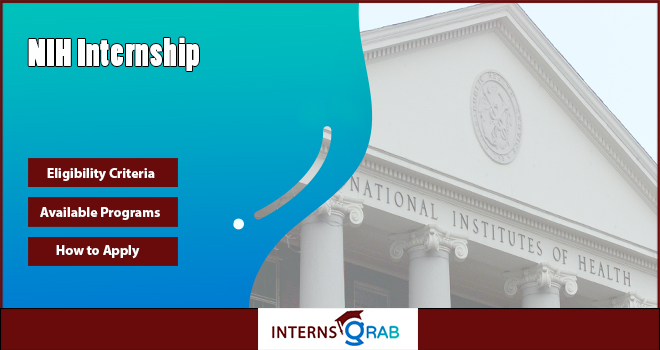Now is the perfect time to find out how medical discoveries are made by applying for an NIH internship. The National Institutes of Health offers one of the most respected research programs in the U.S. It gives students access to real projects in labs that work on cancer, neuroscience, genetics, infectious diseases, and more. Whether you’re just a high school student or you’re already completing your PhD, there’s a program suitable for your academic level and research goals.
The most popular option is the Summer Internship, open to high schoolers, undergraduates, and graduate students across the United States. Applicants get paired with NIH scientists, get involved in actual projects, and often publish or present their findings. With an acceptance rate of around 10 to 15%, getting in is competitive, but completely worth it if you’re serious about biomedical research. The NIH SIP application opens in the fall, so if this sounds like your thing, you’ll want to plan ahead.
![]() For More Healthcare Internships: Click Here
For More Healthcare Internships: Click Here
NIH Internship | Laboratory-Based Research Training

About the National Institutes of Health
The National Institutes of Health (NIH) is the primary agency of the United States government. It is responsible for biomedical and public health research. It falls under the U.S. Department of Health and Human Services and operates as a collection of 27 different institutes and centers. They are all focused on specific areas of medical science, such as cancer, aging, mental health, and infectious diseases.
Headquartered in Bethesda, Maryland, NIH funds and conducts research aimed at improving human health and understanding disease prevention. It supports over 300,000 researchers worldwide, with a significant portion of its $45+ billion annual budget dedicated to external grants. Its current Director is Jayanta Bhattacharya, who leads its efforts in scientific discovery, global health partnerships, and national healthcare innovation.
NIH Internship Program Overview
NIH internships are structured, research-driven programs designed to give students experience in real biomedical labs. Here’s how it works:
- The main program is the SIP, lasting 8 to 10 weeks
- Open to high school, undergraduate, post-baccalaureate, and graduate students
- Interns are paired with NIH researchers in fields like neuroscience, genomics, cancer, AI, and bioinformatics
- Participants work at NIH campuses across the U.S., with the largest in Bethesda, MD
- Internships are full-time and paid, with stipends based on education level
- SIP also includes career development workshops, poster sessions, and NIH lectures
- Some tracks like HiSTEP, HiSTEP 2.0, and CCSEP focus on underrepresented or economically disadvantaged students
- Interns typically receive a monthly stipend of $2,300 to $3,000, depending on their education level.
- Applications typically open in mid-November and close in early February
Types of Internships
NIH offers a variety of student programs that focus on experiential biomedical research and academic improvement. Here are the most common internship types:
- Summer Internship Program (SIP)
Open to high school, undergraduate, and graduate students for 8 to 10 weeks of full-time, paid research work in NIH labs. - High School – Summer Internship Program (HS-SIP)
For juniors and seniors who are at least 17 years old and U.S. citizens, available at the Bethesda campus only. - Graduate Summer Opportunity to Advance Research (G-SOAR)
Designed for current PhD students, this program includes lab research and professional development training. - Post-Baccalaureate IRTA Internship
For recent college graduates who want 1 to 2 years of lab research experience before applying to grad or med school. - Community College Summer Enrichment Program (CCSEP)
Provides research experiences and science education seminars for community college students. - HiSTEP and HiSTEP 2.0
Aimed at underserved high school and early college students interested in exploring science careers.
Eligibility Criteria
Each National Institutes of Health internship has specific requirements depending on the program level. Here’s what students need to qualify for.
- Must be a S. citizen or permanent resident.
- High school applicants must be 17 years or older by June 15 of the internship year.
- Undergraduate and graduate applicants must be enrolled full-time at an accredited institution.
- A minimum GPA of 3.0 is generally expected, but not always required.
- Applicants should have a strong interest in biomedical research or public health.
- Some programs prioritize students from disadvantaged or underrepresented backgrounds.
- Participants must be available to work full-time for 8 to 10 weeks during the summer.
- International students are not eligible unless they are currently enrolled in a U.S.-based academic institution.
How to Apply for the NIH Internship?
It is necessary to prepare in advance for the NIH internship application process, which takes place entirely online. If you would like to apply, please proceed as follows:
- Select “Apply Here” and you’ll be redirected to the institution’s “Careers & Training” webpage.
- Click on “Summer Internship Program” under Programs.
- Choose your program based on your education level (e.g., HS-SIP, SIP, CCSEP).
- Register or log in to the NIH Application Center.
- Fill out the application form with your academic and personal details
- Upload your CV/resume, transcripts, and personal statement.
- Request at least one letter of recommendation through the portal.
- Select up to three NIH institutes or scientists you want to work with.
- Review and submit your completed application before the deadline.
 Grab Your Dream Internships Now | InternsGrab.org
Grab Your Dream Internships Now | InternsGrab.org